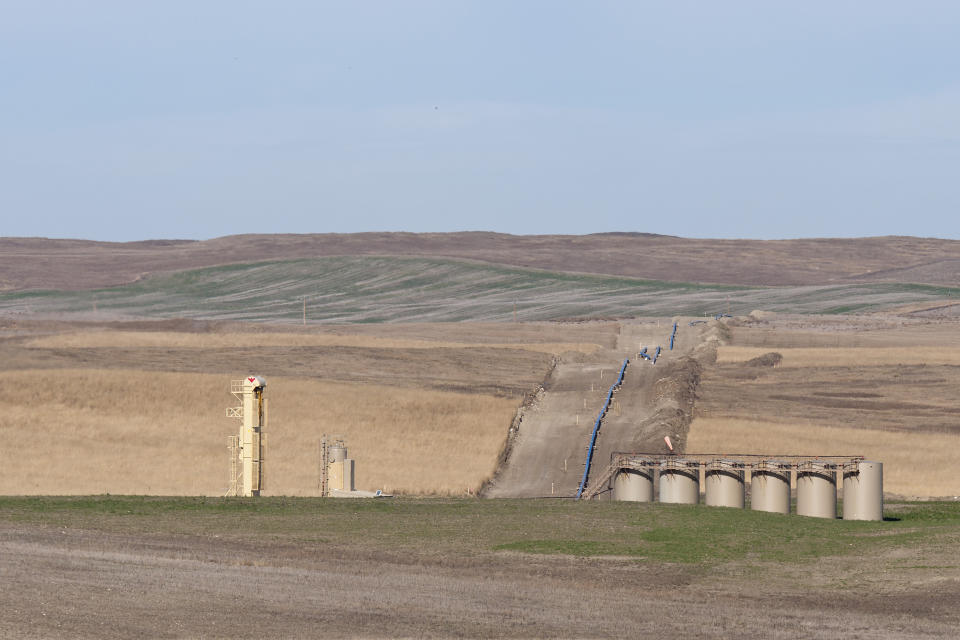Energy Transfer's Controversial Bakken Oil Pipeline Could Soon Get Much Bigger
Energy Transfer (NYSE: ET) fought hard to build the controversial Dakota Access Pipeline, which transports oil out of North Dakota's Bakken shale. The company and its partners had to overcome several obstacles during construction, which caused many delays. However, the pipeline finally started service in June 2017 at an initial capacity of 470,000 barrels of oil per day (BPD).
That pipeline has paid big dividends for the company and its partners over the past two years. Not only did its owners benefit from the initial burst of cash flow by placing the system into service, but they have also since expanded its capacity by 100,000 BPD. However, more growth appears to be coming down the pipeline, since an even larger expansion is in the works, which would nearly double its size.

Image source: Getty Images.
Drilling down into the Bakken Pipeline
Energy Transfer was recently able to secure enough shippers to bring the capacity of the Bakken Pipeline System -- which includes both Dakota Access and the associated Energy Transfer Crude Oil Pipeline -- up to 570,000 BPD. However, on the company's first-quarter conference call, CFO Tom Long noted that the "Bakken pipeline received sufficient market interest during the open season, such that the partners are also progressing with plans to further increase the system capacity by late 2020, in order to meet growing demands for additional takeaway out of the basin." The company has since informed regulators in North Dakota that it's aiming to expand the system to as much as 1.1 million BPD, or roughly double its current size.
The increased capacity "will allow Dakota Access to meet the growing demand from shippers by optimizing and fully utilizing the existing pipeline infrastructure, without the need to install new pipelines," according to the letter by the company to the state's Public Service Commission. Energy Transfer will achieve this by adding new pumping stations so that it can push more oil through the existing pipeline.
By investing to increase the capacity of the current system, Energy Transfer and its partners would earn a much higher return than if they were to build a new pipeline. The initial pipeline, for example, cost them $3.8 billion, while Energy Transfer is only spending about $40 million on new pumping equipment for its current expansion in North Dakota.

Image source: Getty Images.
Competition is heating up for the region's barrels
Energy Transfer, however, isn't the only company looking to increase the flow of oil out of the Bakken. Earlier this month, refining giant Phillips 66 (NYSE: PSX) joined forces with privately held Bridger Pipeline to build the Liberty Pipeline, which they aim to complete by the first quarter of 2021. The $1.6 billion project would move oil from the Bakken and Rockies production areas to a storage hub in Cushing, Oklahoma. From there, it could flow toward the Gulf Coast on any number of other pipelines, including Red Oak, which Phillips 66 plans to build with a different partner. The Liberty Pipeline would receive about 175,000 BPD from the Bakken via the Bridger Extension, which Bridger Pipeline would construct.
Meanwhile, pipeline giant Kinder Morgan (NYSE: KMI) has teamed up with Tallgrass Energy (NYSE: TGE) to pursue the development of a pipeline system that would expand oil transportation capacity out of the Rockies. The project would combine two underutilized natural gas pipelines operated by Kinder Morgan with Tallgrass Energy's Pony Express oil pipeline. This project would add 550,000 BPD to the region's capacity by the second half of 2020, helping improve the flow of crude oil out of the Rockies as well as the Bakken shale and Western Canada. If this project moves forward, it might also enable Kinder Morgan to expand its Double H oil pipeline out of the Bakken, since it could then move that crude further south via the expanded Pony Express pipeline.
The problem with all these proposed oil pipeline projects is that the Bakken might not need all this takeaway capacity. While the Bakken has quietly staged a comeback in recent years and is currently producing about 1.4 million BPD, it appears as if its output will top out at about 2 million BPD by 2022. With regional pipeline and refining capacity currently around 1.5 million BPD, it seems the Bakken will only need about 500,000 BPD of incremental pipeline capacity to support its expected growth. Because of that, it's unlikely that all the currently proposed projects will move forward.
An interesting project to watch
Energy Transfer and its partners are already transporting a large portion of North Dakota's oil production through their Bakken Pipeline System. They'd like an even larger piece of that pie, which is why they're working on potentially doubling that pipeline's capacity. If they're successful, it would be a big win, since the project would probably earn a high return on investment. However, they're going up against a lot of competition, which is why investors should closely monitor their progress on this potentially lucrative investment opportunity.
More From The Motley Fool
Matthew DiLallo owns shares of Kinder Morgan and Phillips 66. The Motley Fool owns shares of and recommends Kinder Morgan. The Motley Fool has a disclosure policy.

